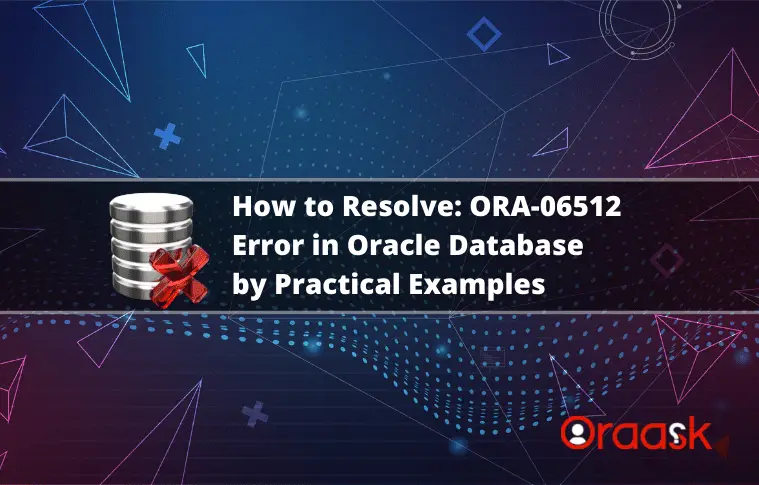Introduction
“ORA-06512 at line num” is a common error message that Oracle Database users encounter while executing PL/SQL code. In this article we are going to provides guidance on how to resolve the error, including possible causes and troubleshooting strategies. It is a helpful resource for anyone experiencing the ORA-06512 error.
ORA-06512 error is a backtrace message that appears when unhandled exceptions occur in PLSQL code. It’s a catch-all error for PLSQL exceptions and is commonly encountered. To solve this, identify the root cause of the exception, check the error stack trace, and use debugging tools like DBMS_TRACE or DBMS_OUTPUT to troubleshoot the issue.
ORA-06512 at Line Error Cause
This is usually the last of a message stack and indicates where a problem occurred in the PL/SQL code. Reference: Oracle documentation
The ORA-06512: At Line (n) error message is a generic PL/SQL error message that happens when an exception is not handled within PL/SQL program.
(n) represent the line number that causes this error to be displayed. it refers to the exact line number within the program to facilitate the troubleshooting process.
Note: If the PL/SQL program has multiple issues in different places and doesn’t have an exception handler section, Oracle will raise and point to the first line that has the issue until fixing it, then check other lines in the case has issues and so on so forth.
ORA-06512 Solution
A common question is How do I fix error ORA-06512? There are two solutions to resolve the ora06512 error, which are:
- Fixing the issue within the PL/SQL program that causes this unhandled exception to raise.
- Write an exception handler for this unhandled exception.
Solution 1: Fix the issue within the PL/SQL program
Let’s take the first example, which expresses the error
DECLARE
L_SITE_NAME VARCHAR2 (6);
BEGIN
L_SITE_NAME := 'Oraask.com';
END;In the above example, we have an anonymous PL/SQL block; when we try to execute it, it will raise an ORA-06512 error as follows:
Error report –
ORA-06502: PL/SQL: numeric or value error: character string buffer too small
ORA-06512: at line 4
- 00000 – “PL/SQL: numeric or value error%s”
*Cause: An arithmetic, numeric, string, conversion, or constraint error
occurred. For example, this error occurs if an attempt is made to
assign the value NULL to a variable declared NOT NULL, or if an
attempt is made to assign an integer larger than 99 to a variable
declared NUMBER(2).
*Action: Change the data, how it is manipulated, or how it is declared so
that values do not violate constraints.
In this error report, the first error ( ORA-06502 ) indicates the exact error that occurred within the program, while the second error line of the error report ( ORA-06512 ) indicates the line number that causes that error.
Basically, in this PL/SQL program, we have tried to assign character values more than L_SITE_NAME variable should hold. We could correct this error by increasing the length of the variable “L_SITE_NAME” to be VARCHAR2 (10).
DECLARE
L_SITE_NAME VARCHAR2 (10);
BEGIN
L_SITE_NAME := 'Oraask.com';
END;Now after updating our script and executing the anonymous PL/SQL block again, it will execute successfully.
PL/SQL procedure successfully completed.
Solution 2: Write an exception handler
Let’s take the second example, which expresses the error
DECLARE
L_OBJECT_CNT NUMBER(1);
BEGIN
SELECT COUNT(OBJECT_ID)
INTO L_OBJECT_CNT
FROM ALL_OBJECTS
WHERE OWNER = 'SYS';
END;In the above example, we have an anonymous PL/SQL block; when we try to execute it, it will raise an ORA-06512 error as follows:
Error report –
ORA-06502: PL/SQL: numeric or value error: number precision too large
ORA-06512: at line 4
*Cause: An arithmetic, numeric, string, conversion, or constraint error
occurred. For example, this error occurs if an attempt is made to
assign the value NULL to a variable declared NOT NULL, or if an
attempt is made to assign an integer larger than 99 to a variable
declared NUMBER(2).
*Action: Change the data, how it is manipulated, or how it is declared so
that values do not violate constraints.
In this error report, the first error ( ORA-06502 ) indicates the exact error that occurred within the program, while the second error line of the error report ( ORA-06512 ) indicates the line number that causes that error.
Basically, in this PL/SQL program, we have tried to assign numerical values more than the L_OBJECT_CNT variable should hold. We could correct this error by adding an exception handling section in the program like below.
DECLARE
L_OBJECT_CNT NUMBER (1);
BEGIN
SELECT COUNT (OBJECT_ID)
INTO L_OBJECT_CNT
FROM ALL_OBJECTS
WHERE OWNER = 'SYS';
DBMS_OUTPUT.PUT_LINE ('L_OBJECT_CNT' || L_OBJECT_CNT);
EXCEPTION
WHEN OTHERS THEN
L_OBJECT_CNT := 0;
END;Now after updating our script by adding the exception-handling part and executing the anonymous PL/SQL block again, it will execute successfully.
PL/SQL procedure successfully completed.
Conclusion
ORA-06512 is a kind of error that aims to help developers troubleshoot by pinpointing the line number causing the problem. And there are multiple ways to handle this kind of error which we explained here in this topic.




